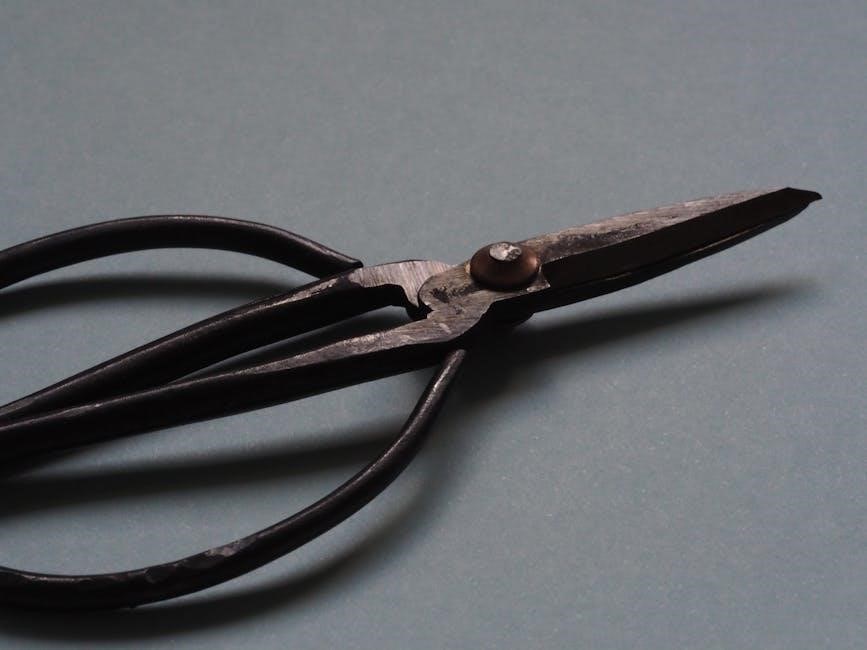This manual provides essential guidance for operating and maintaining JLG scissor lifts‚ including model-specific details‚ safety protocols‚ and troubleshooting tips to ensure efficient and safe equipment use.
1.1 Overview of JLG Scissor Lifts
JLG scissor lifts are reliable‚ versatile aerial work platforms designed for various industrial and construction applications. Models like the 3394RT and 4394RT offer exceptional performance‚ with features such as four-wheel drive‚ diesel engines‚ and impressive lift heights. These lifts are built for durability and efficiency‚ catering to both indoor and outdoor tasks. The 3394RT provides a lift height of 10‚060 mm‚ while the 4394RT reaches up to 13‚110 mm‚ ensuring versatility for different projects. JLG also introduces eco-friendly options like the ES4046 Electric Scissor Lift‚ combining performance with sustainable design to meet modern operational needs.
1.2 Importance of the Manual
This manual is a crucial resource for JLG scissor lift operators and maintenance personnel. It offers detailed guidance on safe operation‚ routine maintenance‚ and troubleshooting‚ ensuring optimal equipment performance. By following the manual‚ users can prevent accidents‚ extend the lifespan of their lifts‚ and comply with safety standards. The manual also includes parts diagrams and electrical-hydraulic schematics‚ making it an essential tool for diagnosing and resolving issues efficiently. Proper adherence to the manual’s instructions is vital for maximizing productivity and maintaining workplace safety.

Model-Specific Information
This section provides detailed specifications and features for JLG scissor lift models such as the 3394RT and 4394RT‚ including their capacities‚ dimensions‚ and operational capabilities‚ ensuring informed usage.
2.1 JLG 3394RT Scissor Lift Specifications
The JLG 3394RT scissor lift is a heavy-duty model designed for rugged applications‚ featuring a maximum lift capacity of 1‚400 lbs and a platform height of 33 feet. It offers a large platform size of 94 inches by 39 inches‚ ideal for multiple workers and equipment. The machine weighs approximately 7‚000 lbs and measures 12 feet 6 inches in length when stowed. It includes a 4-wheel drive system for enhanced stability and traction on uneven terrain. The lift is powered by a robust hydraulic system‚ ensuring smooth and reliable operation in demanding environments.
- Maximum lift height: 33 feet
- Platform size: 94″ x 39″
- Lift capacity: 1‚400 lbs
- Weight: 7‚000 lbs
- Drive system: 4-wheel drive
2.2 JLG 4394RT Scissor Lift Features
The JLG 4394RT scissor lift is equipped with advanced features designed for optimal performance and operator convenience. It boasts a maximum lift height of 43 feet and a platform capacity of 1‚500 lbs‚ making it suitable for heavy-duty tasks. The lift features a 4-wheel drive system for excellent traction on rough terrain and a robust hydraulic system for smooth operation. Other key features include an extendable platform‚ proportional controls for precise movements‚ and an integrated diagnostic system for easy troubleshooting. The 4394RT also offers optional features like LED lighting and a cold-weather package for enhanced versatility.
- Maximum lift height: 43 feet
- Platform capacity: 1‚500 lbs
- 4-wheel drive system
- Proportional controls
- Integrated diagnostic system

Safety Guidelines
Ensure proper training‚ use personal protective equipment‚ and follow manufacturer instructions. Conduct regular inspections and never exceed load capacities. Always maintain three points of contact.
- Wear hard hats and harnesses
- Inspect equipment before use
- Avoid overloading
- Follow emergency exit procedures
3.1 Pre-Operation Safety Checks
Before operating a JLG scissor lift‚ perform a thorough inspection to ensure safe operation. Check hydraulic hoses for leaks‚ electrical connections for damage‚ and tires for proper inflation. Inspect the platform‚ guardrails‚ and safety sensors for integrity. Test all controls‚ including lift‚ lower‚ and emergency stop functions. Ensure the area is clear of obstacles and hazards. Verify that all safety decals and warnings are legible. Review the operator’s manual and ensure proper training has been completed. Always wear required PPE‚ such as a hard hat and harness‚ before starting the machine.
- Inspect hydraulic and electrical systems
- Check platform and safety components
- Test control functions and emergency stops
- Ensure proper PPE is worn
3.2 Emergency Procedures
In case of an emergency‚ follow established procedures to ensure operator and bystander safety. If the scissor lift malfunctions‚ activate the emergency stop and remain calm. Lower the platform to the ground using the manual override or emergency descent system. Evacuate the platform and contact authorized personnel. For hydraulic or electrical failures‚ isolate power sources and secure the area. Refer to the operator’s manual for specific emergency protocols. Always prioritize immediate shutdown and safe evacuation to prevent accidents.
- Activate the emergency stop immediately
- Use manual override to lower the platform
- Evacuate and secure the area
- Contact authorized personnel for assistance

Operating Instructions
This section provides guidance on safely operating the JLG scissor lift‚ including control functions and platform movement. Understand the controls and follow safety protocols to ensure efficient operation.
Key Point: Always familiarize yourself with the controls before operating the lift.
4.1 Starting and Stopping the Scissor Lift
To start the JLG scissor lift‚ ensure the area is clear and all safety devices are functioning. Turn the ignition key clockwise and press the start button. Allow the machine to reach full hydraulic pressure before moving. For stopping‚ lower the lift to the ground using the control levers and engage the parking brake. Turn the ignition key counterclockwise to shut off the engine. Always follow proper shutdown procedures to avoid sudden stops or hydraulic system damage. Emergency stops should only be used in critical situations‚ using the designated emergency stop button.
Remember: Always refer to the manual for specific starting and stopping instructions.
4.2 Controls and Functions
The JLG scissor lift features an intuitive control panel with a ignition switch‚ directional joysticks‚ and function levers. The ignition switch powers the machine‚ while the joysticks control movement and elevation. Function levers operate the scissor lift’s extension and retraction. The emergency stop button halts all operations immediately. Indicator lights on the dashboard monitor system status‚ such as battery levels and hydraulic pressure. The control panel also includes a horn and optional auxiliary controls for attachments. Familiarize yourself with all controls before operation to ensure smooth and safe functionality.
Tip: Always test controls at low elevation before operating at height.

Maintenance and Service
Routine maintenance ensures optimal performance. Follow manufacturer guidelines for hydraulic fluid checks‚ battery maintenance‚ and lubrication of moving parts. Regularly inspect wire ropes and hydraulic hoses for wear.
5.1 Routine Maintenance Procedures
Regular maintenance is crucial for ensuring the scissor lift operates safely and efficiently. Begin with daily checks: inspect hydraulic fluid levels‚ battery water levels‚ and tire pressure. Lubricate moving parts like pivot pins and boom hinges monthly. Check wire ropes and hydraulic hoses for signs of wear or damage. Perform a thorough inspection of safety devices‚ such as limit switches and emergency stops‚ weekly. Clean the machine‚ paying attention to controls and sensors‚ to prevent malfunction. Refer to the manual for specific intervals and procedures to maintain warranty compliance and optimal performance. Neglecting routine maintenance can lead to reduced functionality and increased risk of breakdowns.
5.2 Advanced Service Techniques
Advanced service techniques for JLG scissor lifts involve specialized procedures beyond routine maintenance. These include hydraulic system overhauls‚ such as disassembling and inspecting hydraulic pumps‚ motors‚ and valves for wear. Electrical system diagnostics require advanced tools to troubleshoot issues like faulty sensors or control modules. Battery maintenance involves checking acid levels‚ charging systems‚ and ensuring proper connections to avoid electrical faults. Additionally‚ boom and scissor arm repairs may require precise alignment and welding techniques. Always follow manufacturer guidelines and use genuine parts to ensure optimal performance and safety. Advanced service should only be performed by trained professionals with access to specialized equipment.

Troubleshooting Common Issues
Troubleshooting common issues in JLG scissor lifts involves identifying malfunctions like hydraulic leaks‚ electrical faults‚ or control system errors. Always refer to the manual for specific diagnostic steps and solutions to ensure safety and proper repair.
6.1 Hydraulic System Problems
Hydraulic system issues in JLG scissor lifts often include leaks‚ low fluid levels‚ or pump failure. Common symptoms are reduced lift height‚ slow movement‚ or complete system shutdown. Inspect hoses‚ cylinders‚ and connections for leaks‚ and check fluid levels regularly. Contamination or overheating can also cause malfunctions. Use a pressure gauge to test system pressure‚ and refer to the manual for recommended hydraulic fluid specifications. Addressing these problems promptly prevents further damage and ensures safe operation. Always follow proper diagnostic procedures to identify and resolve hydraulic system issues effectively.
6.2 Electrical System Malfunctions
Electrical system malfunctions in JLG scissor lifts can cause operational disruptions. Common issues include faulty sensors‚ blown fuses‚ or short circuits. Symptoms may include control panel errors‚ erratic motor behavior‚ or complete system shutdown. Check the circuit breaker and wiring harness for damage or corrosion. Use a multimeter to test electrical components for continuity. Ensure all connections are secure and free from debris. Refer to the manual for specific troubleshooting steps and recommended repair procedures. Addressing electrical issues promptly prevents downtime and ensures safe‚ reliable operation. Always follow safety guidelines when working with electrical systems.

Parts Diagram and Replacement
The parts diagram in the JLG scissor lift manual helps identify components for replacement. It ensures proper fit and function‚ maintaining safety and performance standards.
7.1 Identifying Parts and Components

Accurate identification of parts is crucial for maintenance and repairs. The manual provides a detailed parts diagram‚ labeling key components like hydraulic cylinders‚ lift arms‚ and electrical systems. Each part is assigned a specific reference number‚ making it easier to locate and order replacements. Users can cross-reference these numbers with the manufacturer’s catalog or online database. Proper identification ensures the correct parts are used‚ preventing installation errors and safety hazards. Always consult the service manual or contact JLG support for clarification if needed.
- Use the parts diagram to locate components visually.
- Refer to the parts list for corresponding reference numbers.
- Verify compatibility using the serial number.
7.2 Replacement Procedures
Replacing parts on a JLG scissor lift requires precision to ensure safety and functionality. Always disconnect the power source and ensure the lift is on firm‚ level ground. Use specialized tools for hydraulic and electrical components. Follow the torque specifications provided in the manual for bolts and fasteners. Replace one part at a time to avoid confusion. After installation‚ test the system to confirm proper operation. Dispose of old parts responsibly. If unsure‚ consult a certified technician. Proper replacement ensures optimal performance and longevity of the equipment.
- Disconnect power and stabilize the lift.
- Use correct tools and torque specifications;
- Test functionality post-replacement.
Warranty and Support
JLG offers a comprehensive warranty program‚ covering parts and labor for a specified period. Dedicated customer support is available 24/7 for assistance and inquiries.
- Comprehensive warranty coverage.
- 24/7 customer support.
- Online resources and assistance.
8.1 Warranty Coverage Details
JLG scissor lifts are backed by a robust warranty program designed to protect your investment. The warranty typically covers parts and labor for a specified period‚ ensuring reliability and performance. Extended warranty options are also available for added protection. Coverage includes defects in materials and workmanship‚ with certain conditions and limitations. Regular maintenance is required to maintain warranty validity. For detailed terms‚ review the warranty agreement provided with your lift. JLG’s dedicated support team is available to address any warranty-related inquiries or claims‚ ensuring prompt resolution and minimizing downtime.
- Covers parts and labor for a defined period.
- Extended warranty options available.
- Requires regular maintenance for validity.
- Dedicated support for warranty inquiries.
8.2 Customer Support Options
JLG provides comprehensive customer support to ensure optimal performance and minimal downtime. Operators can access 24/7 phone support for urgent assistance. Online resources‚ including manuals‚ troubleshooting guides‚ and FAQs‚ are available for quick reference. Additionally‚ JLG offers live chat and email support for non-emergency inquiries. Certified dealers and service centers provide on-site support‚ parts replacement‚ and training programs. Customers can also utilize JLG’s mobile app for real-time updates and service scheduling. Dedicated account managers ensure personalized support‚ fostering long-term partnerships and customer satisfaction.
- 24/7 phone support for emergencies.
- Online resources and troubleshooting guides.
- Live chat and email assistance.
- Certified dealers for on-site support.

Regulatory Compliance
JLG scissor lifts comply with global safety and environmental standards‚ ensuring adherence to regulations like ANSI‚ ISO‚ and CE marking. Regular compliance checks are essential.
- Meets ANSI and ISO standards.
- Compliant with CE marking requirements.
- Adheres to environmental regulations.
9.1 Safety Standards
JLG scissor lifts are designed to meet strict global safety standards‚ ensuring operator security and equipment reliability. ANSI and EN standards are meticulously followed. The lifts undergo rigorous testing for structural integrity‚ stability‚ and emergency system functionality. Compliance with ISO standards further guarantees international safety adherence. Regular updates ensure alignment with evolving safety regulations. Operators must adhere to these standards during operation to maintain safety. Proper training and adherence to guidelines are essential for safe work practices.
- Meets ANSI and EN standards.
- Structural integrity and stability testing.
- Compliance with ISO standards.
- Regular safety regulation updates.
9.2 Environmental Regulations
JLG scissor lifts are designed to comply with environmental regulations‚ minimizing their ecological impact. EPA and EU emissions standards are strictly followed. The equipment incorporates eco-friendly materials and energy-efficient technologies. Proper disposal of hazardous materials is emphasized; Operators must adhere to local environmental laws during operation and maintenance. Sustainable practices are encouraged throughout the equipment’s lifecycle. JLG supports global environmental initiatives to reduce carbon footprints and promote green practices in the industry.
- Compliance with EPA and EU emissions standards.
- Eco-friendly materials and energy efficiency.
- Proper disposal of hazardous materials.
- Adherence to local environmental laws.

Environmental Impact
JLG scissor lifts are designed to minimize environmental impact through reduced emissions and energy-efficient operation. Electric models offer eco-friendly alternatives‚ while sustainable manufacturing practices reduce waste.
10.1 Eco-Friendly Features
JLG scissor lifts incorporate eco-friendly features to reduce their environmental footprint. Electric models are powered by clean energy‚ eliminating emissions and noise pollution. Advanced battery technologies extend runtime and reduce charging cycles. Many units are designed with recyclable materials‚ promoting sustainability. Energy-efficient hydraulic systems minimize fluid usage‚ lowering waste. Additionally‚ JLG offers biodegradable hydraulic fluids as an option‚ further reducing environmental impact. These features ensure that JLG scissor lifts not only meet but exceed environmental standards‚ making them a responsible choice for modern construction and industrial applications.
10.2 Sustainable Practices
JLG promotes sustainable practices through responsible manufacturing and operational strategies. The company emphasizes recycling programs for end-of-life equipment‚ reducing waste by reusing or repurposing components. Energy-efficient manufacturing processes minimize resource consumption. Additionally‚ JLG encourages eco-friendly supply chain practices‚ ensuring materials are sourced responsibly. Operators are advised to follow proper disposal guidelines for batteries and fluids. By integrating these practices‚ JLG supports environmental stewardship while maintaining high-performance standards in their scissor lifts‚ aligning with global sustainability goals and promoting a greener future for industrial equipment.